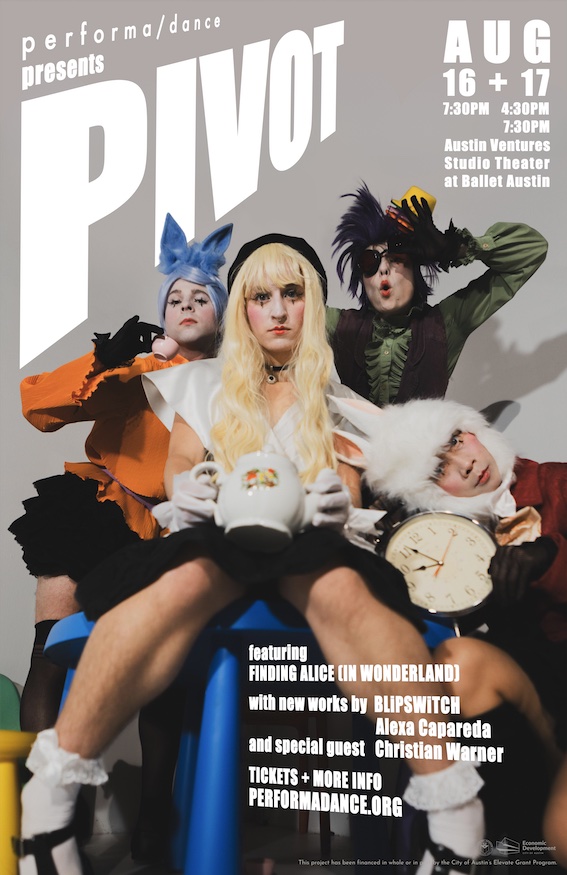Review: Pivot by Performa/Dance
by David Glen Robinson
The group ballet show Pivot has just closed its brief run at Austin Ventures Studio in downtown Austin. Produced by Performa/Dance, Pivot was exemplary of new ballet, which incorporates new concepts and performance practices and addresses social issues.
Performa/Dance deconstructs creative material that comes its way, embracing hybridity and incorporating new media and forms unusual or unheard of in traditional ballet. Yet the company’s performances can be considered nothing other than ballet. Hence the fault line in the name of the company.
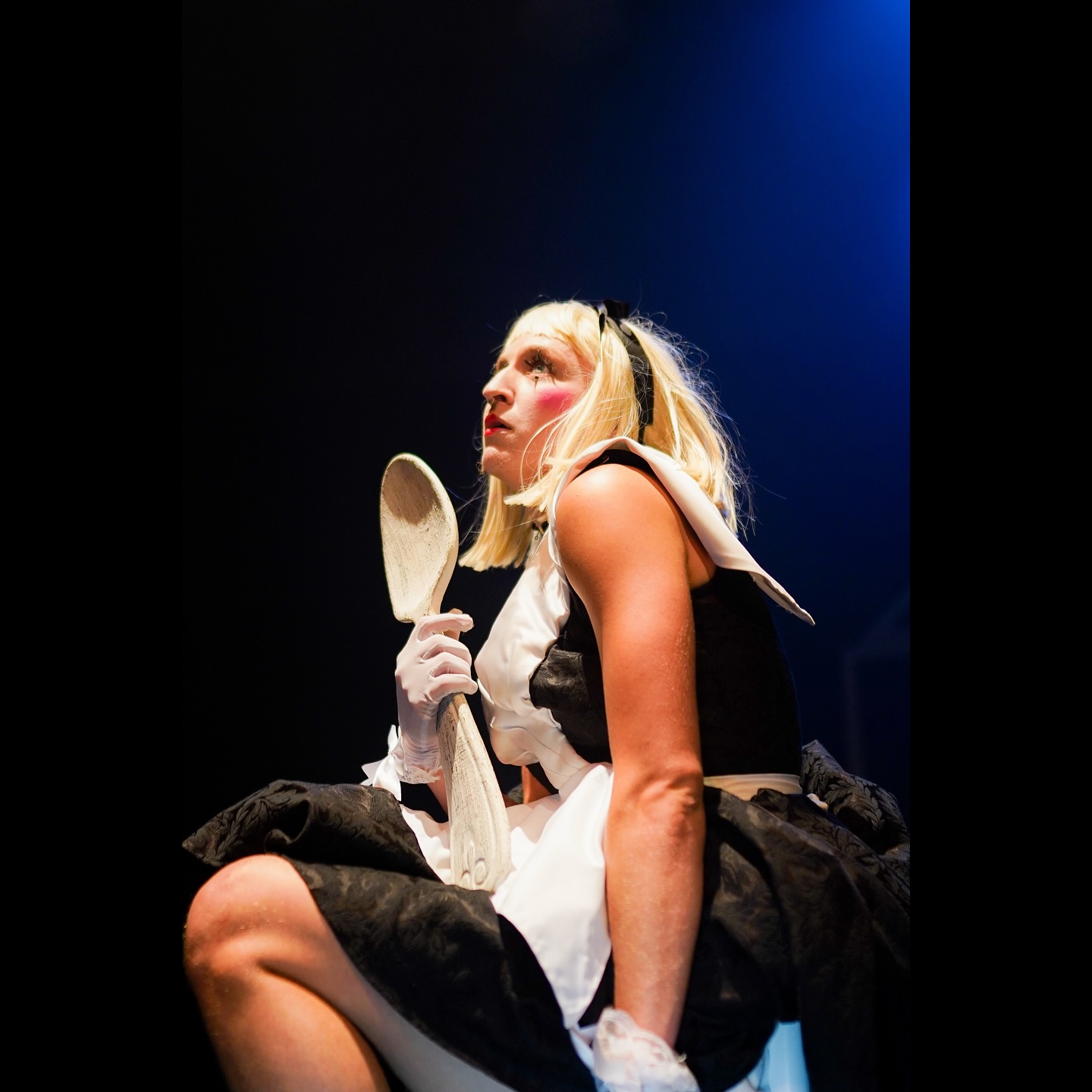 Performa/Dance under the leadership of Jennifer Hart has crafted a rare achievement: a new departure in ballet and fine arts. The company swims in the milieu of new ballet. Along with Austin companions Ballet Austin, Ventana Ballet, Red Nightfall Productions, and Ballet Austin II, it addresses new themes far from the traditional ballet canon. Performa/Dance’s Finding Alice (in Wonderland), part of this show, is only the current example. It leaps headlong down the rabbit hole of new ballet.
Performa/Dance under the leadership of Jennifer Hart has crafted a rare achievement: a new departure in ballet and fine arts. The company swims in the milieu of new ballet. Along with Austin companions Ballet Austin, Ventana Ballet, Red Nightfall Productions, and Ballet Austin II, it addresses new themes far from the traditional ballet canon. Performa/Dance’s Finding Alice (in Wonderland), part of this show, is only the current example. It leaps headlong down the rabbit hole of new ballet.
Complexity inheres in the new, and that's why it's rare to encounter really new approaches to art. Performa/Dance artistic director Jennifer Hart choreographed and directed the ensemble for Finding Alice, reinterpreting Lewis Carroll’s 1865 child’s tale through the talents of Kelsey Oliver and ensemble performers Alexa Capareda, Taryn Lavery, and Colin Heino. Capareda assistant directed.
Finding Alice is, among other things, a massive deconstruction of Lewis Carroll’s tale. Kelsey Oliver as Alice leads us on the heroine’s quest and encounters Wonderland's monstrous guides and nonsense teachers the hookah-ing Caterpillar, the White Rabbit, the Cheshire Cat, and the Red Queen. All action was danced in perfected ballet technique with a few gymnastically shaped phrases uncategorizable as to genre. Oliver’s spoken words reframed the meanings of the tale into the modern search for identity in sex and sexuality, strangeness, and queerness. Alice’s Adventures in Wonderland for the moderns, in short.
Alice and Hart happily lift lines out of Carroll for direct deconstruction and the obvious temporal shift required for a postmodern telling. The ensemble dancers offer a sort of spoken word canon of one trenchant line, repeated and highlighted by their movement sequence: “Dear, dear, how queer everything is today, and everything yesterday was just the same.” The line is a bridge between the semantics of the term "queer" in Carroll’s Victorian days and our modern usage of it in our post Stonewall, Gay Revolution era. The term’s denotation of gay sex and sexuality now is very much to the fore, but in Carroll’s time many such terms, while presented and used innocently, also alluded sotto voce to darker subthemes in the arena of sex. Carroll may have whispered quietly to the twenty-first century, and Finding Alice heard him.
Wonderland's magical beings entered in uniform black lace ballet garb. These ensemble members were morphs, little quasi-characters donning character costumes to dance new identities in interaction with Alice. Morphs did the stage work of moving props and stage furniture on and off, all while dancing ballet, a deft approach to stage management. Gone were the black-garbed and often overweight nondancer stagehands who typically disrupt and distract the flow of the performance even while furthering it. These morphs never slowed the pace to a pedestrian walk, and their movements were adapted to assigned choreographed tasks. As Alexa Capareda described it, the Morph Walk was “a cross between a jellyfish and a frog.” Odd, brilliant, and well-executed.
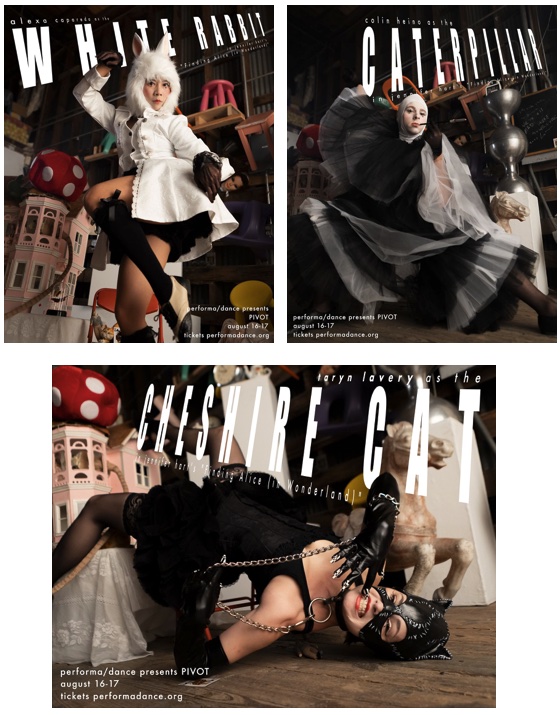
Taryn Lavery danced the Cheshire Cat in fetish black leather, various spiky bits protruding all over and claws on gloves painted like modern garish nail painting. Her pop culture look closely resembled Cat Woman of the Batman movies. The dance became suitably sinuous until White Rabbit handed her a lighted cosmetics magnifying glass. Lavery held it up to her shining teeth. They appeared to grow larger and larger until the Cheshire Cat was nothing but a smile in darkness.
Colin Heino shone brightly in his dance as the Caterpillar, although he was virtually invisible in tulle. It was not the layered look; it was the stacked look. He danced in stacked black and white rings of tulle petticoats neck to toe. The costume conveyed the impression of a huge, segmented caterpillar. (Important note: Kelsey Oliver was also the costume designer for Finding Alice.) White Rabbit supplied the Caterpillar with an exaggeratedly long cigarette holder to represent the iconic hookah. The dance was a highly abstracted duet between Heino and Oliver with aggressive advances and mysterious internal retreats. Alice was leftwith more questions than answers—one more step toward adulthood.
Alexa Capareda as White Rabbit wore a white furred hood with rabbit ears. She danced through many scenes as in Carroll’s story, dropping or picking up props with bravura and dramatic shapes, frequently to applause. As assistant director, she led ensemble dances, including some with Alice. Here the ballet choreography established itself and transported us to that heightened esthetic realm ballet has always commanded, perhaps unique in the fine arts.
_adj.jpg) Kelsey Oliver's movement as Alice occasionally shifted to a simple walk to signal a transition and modulate the emotional atmosphere. The rest of the time she performed powerful ballet phrases and sequences including obvious contemporary dance phrases. Noteworthy in this last mode was when she lay on her back downstage with her knees up. Keeping that posture, she advanced across the stage by a series of strong abdominal contractions that thrust her along the marley floor without assistance from arms and legs. Oliver is known for creative movement in her floorwork, but this sequence hadn't been seen before.
Kelsey Oliver's movement as Alice occasionally shifted to a simple walk to signal a transition and modulate the emotional atmosphere. The rest of the time she performed powerful ballet phrases and sequences including obvious contemporary dance phrases. Noteworthy in this last mode was when she lay on her back downstage with her knees up. Keeping that posture, she advanced across the stage by a series of strong abdominal contractions that thrust her along the marley floor without assistance from arms and legs. Oliver is known for creative movement in her floorwork, but this sequence hadn't been seen before.
Oliver’s vocal work stressed thematic references, notably “My work is me, my identity,” and “But then the question is, who am I?” The answers presented to her in Wonderland seemed matched by chaos. Chaos and its handmaiden anger culminated in the scene of Oliver as the Red Queen. She wore a red knit costume with spiked truck hub cap crown and wielded a battleax. The dance was almost too intense to watch. The Red Queen dismantled every morph and character in perfect ballet technique.
Description of part of the end of Finding Alice is fair game because the production is finished and no revival has been announced. The end of the piece was rather opaque. Alice approached a large doll house kept well-lit downstage through the show. The morphs joined her there. They all groped inside the rooms searching for objects, and the morphs left the stage with their finds. Alice stood away from the doll house holding three small dolls to her apron front, perhaps a family unit. Families of choice? Jennifer Hart’s autobiography? The lights faded. The concluding statement, if any, floated in the darkness of uncertainty. But as we know, ambiguity is delicious.
* * *
Pivot was a group dance show of four unrelated pieces, Finding Alice, the only piece choreographed by Jennifer Hart, was one of them.
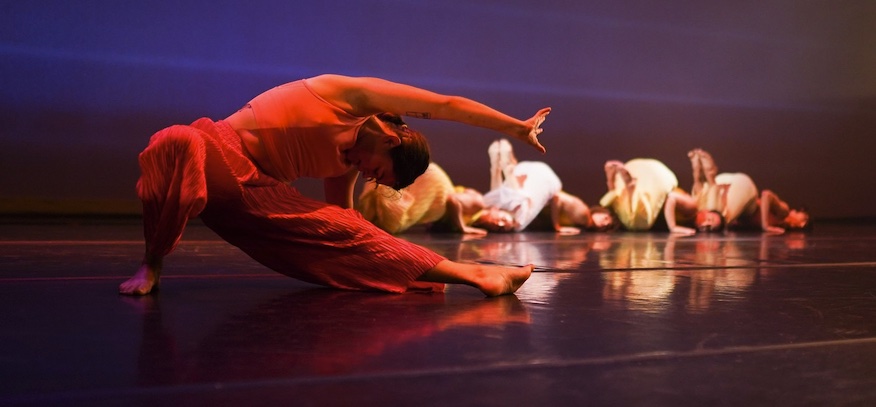
Hyperbaton was a contemporary dance piece created by rising Austin company BLiPSWiTCH, opened the show. Five female dancers, Alex Miller, Taryn Lavery, Lisa Schreck, Katie Lowen, and Carissa Topham Fisher performed the piece. The choreographic credit went to BLiPSWiTCH (the collective), Alex Miller, and Taryn Lavery. Hyperbaton featured much group floor work with breakout solos rising from the floor and descending back down to it. A leitmotif in Hyperbaton and other BLiPSWiTCH works is the creation of lines of performers in shapes on the stage floor, all linked or touching in some way. The linear shapes held their places upstage and framed downstage solos or elsewhere in the wider-than-deep Austin Ventures Studio space. One rather static and innovative solo by Alex Miller offered much intrigue. She sat on the floor away from the group, hands around her knees. Her head turned at right angles to her body, toward the audience. The shape reminded us of courtyard Chacmool statues from ancient Mexico. Different sections of Miller’s head, primarily her face, would quiver or shake for a few seconds while she maintained her statuelike seated posture. Facial quaking would stop, then take up again on different parts of her face. Her dance of the face persisted only briefly toward the end of the piece and lacked any foreshadowing in earlier movement or tableaux. Altogether, Hyperbaton was impressive as a highly abstract work of contemporary dance. Michael Brown and Brett Marcum composed the music soundtrack for the piece.
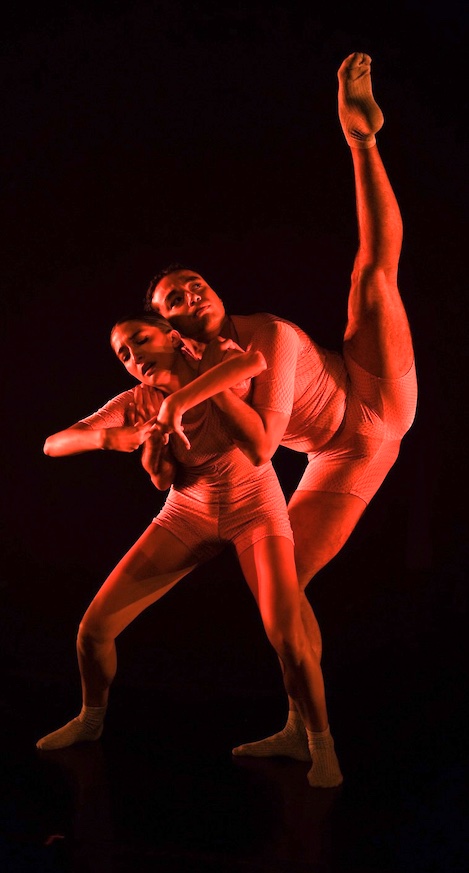
Alex Capareda, Performa/Dance assistant director, choreographed the ballet duet Cautery. It was a deeply personal artistic statement. Dancers Alyssa Manguiat and Arnaldo Hernandez performed in skin-tight, color-matched ballet costumes. The apparent concept was that the two bodies were one when in contact, so that breaking apart was the loss or removal of conjoined parts. And of course, the ballet dancers demonstrated the great flexibility and balance that comes with perfected technique. The program notes stated the rationale for the dance and its importance: “Cautery depicts the visceral urge to remove, burn off, or destroy undesired parts of oneself. The dancers in this pas de deux represent parts of a whole and the human struggle to be free of that which causes pain.” The dancers demonstrated this concept with exquisite ballet movement. One loving dancer fell away from the other in an especially heartbreaking moment in an altogether beautiful and sensitive dance.
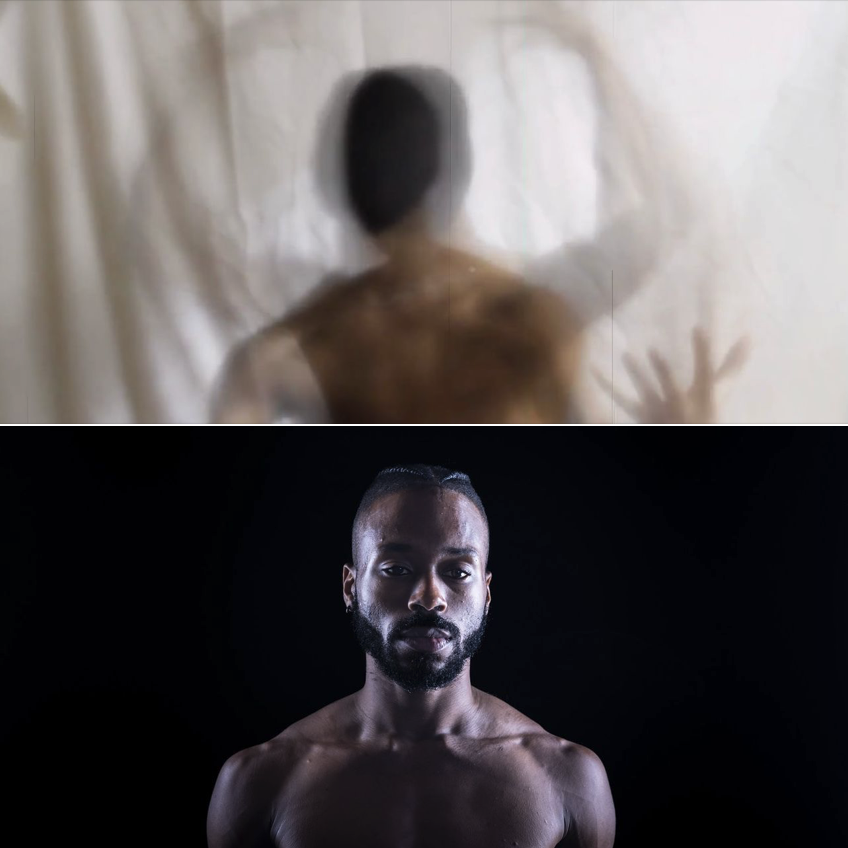
Special guest from NYC Christian Warner performed the solo piece White Hot Room. His multimodal piece is a very personal statement under development since its 2019 premiere. With song, spoken word, mimetic acting, and character dance, Warner generalized for the world his life as a young African American with sometimes fearful forays into multiple identities and gender roles. Throughout the performance, Warner referenced his connection with his wider family. The piece was a beautifully polished and finished statement of hope in an uncertain and racially riven world.
The producing staff of Pivot, most of them affiliated with Austin Ventures Studio of Ballet Austin, supported the artists in their usual professionally polished manner. Lighting designer and technical director Steven Myers led the team. Elisa Noemi was both stage manager and sound operator. Dani Casey provided ASL interpretation for the Saturday matinee. Ritika Bhattacharjee coordinated the score for Finding Alice.
Follow Performa/Dance on social media and their Facebook page to learn of their future projects. Their work is satisfying to all aficionados of the fine arts.
Pivot
by Performa/Dance
Performa/Dance
August 16 - August 17, 2024
WHO: Performa/Dance
WHAT: “PIVOT”
WHEN: August 16th, 7:30pm and August 17th, 2024 at 4:30pm and 7:30pm
WHERE: Ballet Austin, AustinVentures StudioTheater
501 W 3rd St, Austin, TX 78701
TICKETS: $25-50, performadance.org
The performance runs 75 minutes, with a 15-minute intermission. This production is supported in part by the City of Austin’s Elevate Grant Program.
